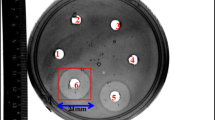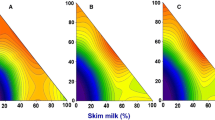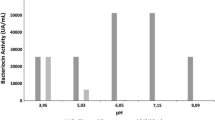Abstract
The production of pediocin in milk by Pediococcus acidilactici was evaluated in co-culture with the dairy fermentation cultures Streptococcus thermophilus and Lactobacillus delbrueckii ssp. bulgaricus. The cultures were tested singly and in different combinations in milk (0 or 2% fat content) during incubation at 40°C for up to 10 h. Cell-free milk samples taken every 60 min were tested for bacteriocin activity against Listeria monocytogenes. Pediocin activity was not detectable when P. acidilactici was inoculated into milk as a monoculture. When P. acidilactici was grown in combination with the yogurt starter cultures S. thermophilus and Lb. delbrueckii ssp. bulgaricus, pediocin concentration reached 3,200–6,400 units ml−1 after 8 h of incubation. The results showed that pediocin producing pediococci may be useful adjunct components in mixed cultures of S. thermophilus and Lb. delbrueckii ssp. bulgaricus to amplify the bioprotective properties of fermented dairy foods against Listeria contamination.
Similar content being viewed by others
References
Benkerroum N, Sandine WE (1989) Inhibitory action of nisin against Listeria monocytogenes. J Dairy Sci 71:3237–3245
Benkerroum N, Oubel H, Sandine WE (2003) Effect of nisin on yogurt starter, and on growth and survival of Listeria monocytogenes during fermentation and storage of yogurt. Int J Food Saf 1:1–5
Bhowmik T, Marth EH (1990) β-Galactosidase of Pediococcus species: induction, purification and partial characterization. Appl Microbiol Biotechnol 33:317–323
Biswas SR, Ray P, Johnson MC, Ray B (1991) Influence of growth conditions on the production of a bacteriocin, pediocin AcH, by Pediococcus acidilactici H. Appl Environ Microbiol 57:1265–1267
Burgos-Rubio CN, Okos MR, Wankat PC (2000) Kinetic study of the conversion of different substrates to lactic acid using Lactobacillus bulgaricus. Biotechnol Prog 16:305–314
Caldwell SL, McMahon DJ, Oberg CJ, Broadbent JR (1996) Development and characterization of lactose-positive Pediococcus species for milk fermentation. Appl Environ Microbiol 62:936–941
Chen H, Hoover DG (2003) Bacteriocins and their food applications. Compr Rev Food Sci Food Safety 2:82–100
Choi HK, Schaack MM, Marth EH (1988) Survival of Listeria monocytogenes in cultured buttermilk and yogurt. Milchwissenschaft 43:790–792
Cleveland J, Montville TJ, Nes IF, Chikindas ML (2001) Bacteriocins: safe, natural antimicrobials for food preservation. Int J Food Microbiol 71:1–20
Coderre PE, Somkuti GA (1999) Cloning and expression of the pediocin operon in Streptococcus thermophilus and other lactic fermentation bacteria. Curr Microbiol 39:95–301
De Buyser ML, Dufour B, Maire M, Lafarge V (2001) Implication of milk and milk products in food-borne diseases in France and in different industrialized countries. Int J Food Microbiol 67:1–17
De Vin F, Radstrom P, Herman L, De Vuyst L (2005) Molecular and biochemical analysis of the galactose phenotype of dairy Streptococcus thermophilus strains reveals four different fermentation profiles. Appl Environ Microbiol 71:3659–3667
De Vos WM, Vaughan EE (1994) Genetics of lactose utilization in lactic acid bacteria. FEMS Microbiol Rev 15:217–237
Drider D, Fimland G, Hechard Y, McMullen LM, Prevost H (2006) The continuing story of class IIa bacteriocins. Microbiol Mol Biol Rev 70:564–582
Gahan CGM, O’Driscoll B, Hill C (1996) Acid adaptation of Listeria monocytogenes can enhance survival in acidic foods and during milk fermentation. Appl Environ Microbiol 62:3128–3132
Henderson JT, Chopko AL, van Wassenaar PD (1992) Purification and primary structure of pediocin PA-1 produced by Pediococcus acidilactici PAC-1.0. Arch Biochem Biophys 295:5–12
Hutkins RW, Morris HA, McKay LL (1985) Galactose transport in Streptococcus thermophilus. Appl Environ Microbiol 50:772–776
Kumar N, Prasard DN (1994) Effect of incubation period on inhibitory action of nisin in skim milk against lactic and non-lactic microorganisms. Microbiol Alim Nut 12:163–164
Lammerding AM, Doyle MP (1989) Evaluation of enrichment procedures for recovering Listeria monocytogenes from dairy products. Int J Food Microbiol 9:249–268
Marth EH, Ryser ET (1990) Occurrence of Listeria in foods: milk and dairy foods. In: Miller AL, Smith JL, Somkuti GA (eds) Foodborne Listeriosis. Elsevier, New York, pp 151–164
Mora D, Fortina MG, Parini C, Ricci G, Gatti M, Giraffa G, Manachini PL (2002) Genetic diversity and technological properties of Streptococcus thermophilus strains isolated from dairy products. J Appl Microbiol 93:278–287
Osmanagaoglu O, Beyatli Y, Gunduz U (2000) Cloning and expression of a plasmid-linked pediocin determinant trait of Pediococcus acidilactici F. J Basic Microbiol 40:41–49
Ray SK, Johnson MC, Ray B (1989) Bacteriocin plasmids of Pediococcus acidilactici. J Ind Microbiol 4:163–171
Ribeiro SHS, Carminati D (1996) Survival of Listeria monocytogenes in fermented milk and yogurt: effect of pH, lysozyme content and storage at 4°C. Sc Alim 16:175–185
Schaack MM, Marth EH (1988) Survival of Listeria monocytogenes in refrigerated cultured milks and yogurt. J Food Prot 51:848–852
Schved F, Lalazar A, Henis Y, Juven BJ (1993) Purification, partial characterization and plasmid-linkage of pediocin SJ-1, a bacteriocin produced by Pediococcus acidilactici. J Appl Bacteriol 74:67–77
Smith JL, Palumbo SA (1983) Use of starter cultures in meats. J Food Prot 46:997–1006
Somkuti GA, Steinberg DH (2003) Pediocin production by recombinant lactic acid bacteria. Biotechnol Lett 25:473–477
Somkuti GA, Steinberg DH (1988) Genetic transformation of Streptococcus thermophilus by electroporation. Biochemie 70:579–585
Somkuti GA, Steinberg DH (1979) Adaptability of Streptococcus thermophilus to lactose, glucose and galactose. J Food Prot 42:885–887
Author information
Authors and Affiliations
Corresponding author
Rights and permissions
About this article
Cite this article
Somkuti, G.A., Steinberg, D.H. Pediocin production in milk by Pediococcus acidilactici in co-culture with Streptococcus thermophilus and Lactobacillus delbrueckii subsp. bulgaricus . J Ind Microbiol Biotechnol 37, 65–69 (2010). https://doi.org/10.1007/s10295-009-0648-2
Received:
Accepted:
Published:
Issue Date:
DOI: https://doi.org/10.1007/s10295-009-0648-2




